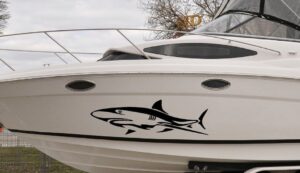Docking your pontoon for the first few times can be a little intimidating for those who have just switched to a pontoon or are new to boating. In that you internalize the size and shape of the object even though you can’t see it, docking a pontoon is similar to parallel parking a car after you’ve done it a few times. Reading this article carefully will help you learn how to dock a pontoon boat.
How To Dock A Pontoon Boat?
Preparation For Docking
Have your fenders set up and your dock lines prepared before you even start to approach the dock. Tell your crew what they can do to help, such as manning the dock lines and being prepared to jump off the boat to secure those lines, if you have one on board.
Make a reconnaissance pass to learn the following information if you are unfamiliar with the dock:
- How you’ll approach the dock;
- Which side of the boat you’ll be docking on;
- The location of cleats for tying up to the dock;
- Additionally, note the height of the dock so that your fenders can be adjusted for maximum boat protection.
Watch the wind and the current. You’ll have more control over your boat’s speed if you can try to approach a dock with the wind at your back. A pontoon is extremely vulnerable to cross winds because of its profile.
Try to gauge the wind as you get closer to the dock; start off aiming slightly upwind and you’ll drift into the perfect position without having to make many steering adjustments. With practice and getting to know the boat, this becomes simpler.
Enhancing Your Vision
The fence enclosing the deck and the distance between the helm and the front of the boat frequently make it difficult for the person at the pontoon’s helm to see the dock.
When you’d really like to see the dock, those sightlines get worse as you get closer to it. Here are some additional suggestions.
- The elevated helm station provided by many pontoon boat builders raises the seat by four to six inches and somewhat enhances sightlines.
- Slide the steering wheel all the way up, slide the helm seat all the way back, and try standing at the wheel. Your forward and port views will both be improved as a result.
- Invite your guests to move out of your line of sight. Have everyone at least take a seat. Place them in the back seats, even better. You will only be able to see guests standing on the deck in front of you.
- To board, open the front gate. If there is a pier at the head of the slip, you will be able to better judge your forward approach.
When it is possible, the captain will have a much better view when docking to starboard rather than port.

Slow Approach
Approaching the dock must always be done slowly. More time will be given to you to respond and decide. It’s also better to lightly tap the dock rather than strike it firmly enough to cause damage.
- Bump the boat in and out of gear as you draw near. While maintaining a low speed, you still want some steering control.
- On the strength of its own momentum, a pontoon can travel quite a distance.
- Change to reverse to slow down when you are about 10 feet from where you want the boat to come to a stop.
Where Should You Dock Your Pontoon Boat?
The vast majority of pontoon boats are docked at a port or a private dock. Locations for pontoon boat anchoring can be assigned to various kinds of docks. Pontoon boats can be moored at four different types of docks.
Read More:
Boat Lift
It allows for the simple docking of pontoon boats. It can be utilized to completely remove the pontoon from the water. It is a procedure that can stop corrosion and disasters brought on by changing water depth.
The boat lift is frequently used alongside a fixed dock as an extra safety measure to reduce the development of algae, barnacles, or mussels.
Floating Docks
This kind of dock is used in locations with variable water depths, like seashores and deep sea bays. It is similarly permanent to the fixed dock. The difference is that when the water depth changes, floating is always expected.
Stationary Docks
This dock is at a predetermined location and is appropriately erected in accordance with its name. It has a traditional appearance and is supported by poles and posts. This is the best option, in the opinion of experts, for protecting your craft from winds and waves.
Your boat could nevertheless collide with the dock, which is a possibility. This is more likely to happen if the mooring lines aren’t long enough to account for changes in water levels, tides, or currents.
Portable Docks
Since pontoon boats are kept on land during the off-season, this is preserved. When there is ice on the waterways, it is frequently used in those areas. A portable dock is your best bet because the water freezes during the winter. Commonly, level ground is used to install portable docks. Additionally, it is made to be wheeled.
Tips For Docking Your Pontoon Boat
Reduce The Speed
Reducing your engine’s speed is nothing to be afraid of. It’s not a problem if you unintentionally use reverse for a longer period of time than you intended and the boat comes to a stop.
Re-start the motor to move forward once more. When the boat is cruising, switch the engine back to neutral as you get ready to shift into reverse.
Boat Fenders
It’s a good idea to have side fenders on board even if you know how to dock the boat because accidents do happen occasionally. If another boat collides with yours, boat fenders might be able to save your crew.
Weather Checking
I already recommended moving slowly toward the pier to gain more control. That might not be possible, though, if you are facing strong waves or gusts.
A gradual approach might result in your boat moving in the opposite direction in these difficult conditions. You should move closer than usual in order to maintain momentum.
Conclusion
Correct docking is a necessary part of safety measures when traveling with your pontoon boat. The tips in this article will give you the assurance you need to dock a pontoon boat. Keep in mind to practice frequently to develop your skills. You’ll appear to be a captain from birth with a little practice.



